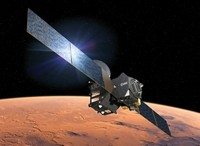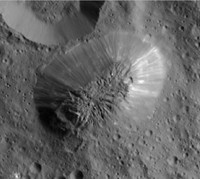Advertisement
Grab your lab coat. Let's get started
Welcome!
Welcome!
Create an account below to get 6 C&EN articles per month, receive newsletters and more - all free.
It seems this is your first time logging in online. Please enter the following information to continue.
As an ACS member you automatically get access to this site. All we need is few more details to create your reading experience.
Not you? Sign in with a different account.
Not you? Sign in with a different account.
ERROR 1
ERROR 1
ERROR 2
ERROR 2
ERROR 2
ERROR 2
ERROR 2
Password and Confirm password must match.
If you have an ACS member number, please enter it here so we can link this account to your membership. (optional)
ERROR 2
ACS values your privacy. By submitting your information, you are gaining access to C&EN and subscribing to our weekly newsletter. We use the information you provide to make your reading experience better, and we will never sell your data to third party members.
Physical Chemistry
Briny Liquid Water Found On Mars
Space Science: Discovery provides target for future explorations of possible martian life
by Elizabeth K. Wilson
October 1, 2015
| A version of this story appeared in
Volume 93, Issue 39
Scientists announced they have observed seasonal trickles of briny liquid water flowing down sloped surfaces of Mars (Nat. Geosci. 2015, DOI: 10.1038/ngeo2546).

Although the source of the water is yet unknown, the case for flowing liquid is nearly unequivocal, thanks to spectra collected by the National Aeronautics & Space Administration’s Mars Reconnaissance Orbiter (MRO), which identified aqueous salts in the dark streams
This discovery provides a new, definitive target for the search for life on Mars.
“The existence of liquid water, even if super salty, gives us the possibility to describe a way how life might survive,” said John Grunsfeld, the associate administrator for the science mission directorate at NASA, at a press conference last week. “Now, this question is not abstract—it’s a concrete one we could answer.”
Although ample evidence exists that ancient Mars was covered with watery oceans and lakes, there’s never been conclusive evidence that liquid water exists there now.
Nearly 10 years ago, NASA’s
“We know there have been these streaks, possibly caused by water, but that key evidence was missing: their chemical identity,” said Georgia Institute of Technology’s Lujendra Ojha during last week’s conference. Ojha is lead author on the new work.
The resolving power of the MRO’s spectrometers allowed team members to analyze the flowing features in visible and infrared wavelengths. The spectra showed clear evidence for hydrated varieties of magnesium perchlorate, magnesium chlorate, and sodium perchlorate.
The presence of the hydrated minerals is a smoking gun for water in its liquid state. The salts lower the freezing point and slow the rate of evaporation of water, making the liquid stable despite Mars’s cold temperatures and low pressures.
The new observation also meshes with the discovery of perchlorate ions in soil samples dug up by NASA’s Phoenix lander in 2008.
There are numerous theories about the water’s source, team scientist Mary Beth Wilhelm said at the conference, including the possibility of underground aquifers. Deliquescence, a process in which hygroscopic minerals in soil absorb water from the atmosphere, “is our favorite scenario,” she said.
However, Norm Sleep, a geophysics professor at Stanford University, hypothesizes Mars may harbor reservoirs of subsurface water free of the perchlorates.
“The subsurface water reservoir likely has moderate salinity and is quite habitable,” he told C&EN. Water that rises to the surface likely then dissolves the perchlorate salts, he said.
Whether these brines could be habitable is yet unknown. “We need to determine how cold and how strong the brine is,” Jim Green, planetary science division director at NASA, said at the conference. “We now have a great opportunity to be on the right location to investigate the possibility of life on Mars.”
This article has been translated into Spanish by Divulgame.org and can be found here.





Join the conversation
Contact the reporter
Submit a Letter to the Editor for publication
Engage with us on Twitter